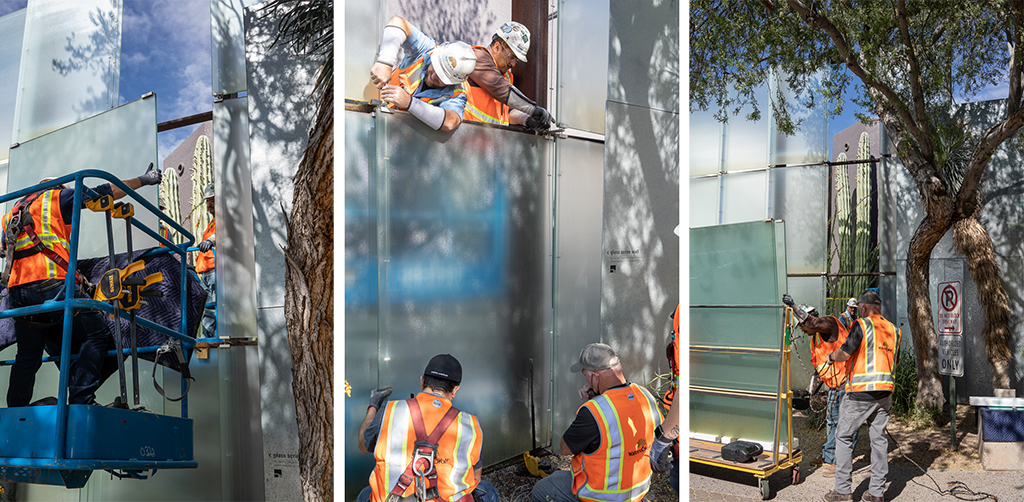Glass Scrim Wall is Assessed for Future Restoration

Glass Scrim Wall by James Carpenter Design Associates is a public art commission that was completed in 2001 as a physical and visual barrier between the Nancy and Art Schwalm Sculpture Courtyard at Scottsdale Museum of Contemporary Art (SMoCA) and the adjacent street. The wall is composed of 56 laminated translucent glass panels, each approximately 4 feet by 7 feet, hung from a curving steel structure, 21 feet high and 65 feet long.
Unfortunately, the specific type of glass the panels used has been discontinued, and we have installed all the extra panels provided with the commission for repairs. So, faced with needed repairs and in anticipation of future needs, Scottsdale Public Art and James Carpenter Design have come together to assure the lifetime of Glass Scrim Wall with plans to replace all the panels with new glass.

Recently, a representative from James Carpenter Design Associates came to Scottsdale to assess the wall with workers from the contractor Walters & Wolf. This involved viewing the wall’s current condition, testing the structure, and establishing an installation protocol by removing one whole section of panels and reinstalling them.
Once this first phase of work was completed, we took the opportunity to ask James Carpenter Design a few questions related to this project:
1. Tell us about yourself and your role with James Carpenter Design Assocaites and what you work on with for them.
My name is Kate McClellan and I have been with JCDA as a designer for over 20 years, and I was here when the original artwork was designed and installed and am familiar with the materials and process of the artwork. As project manager, I am overseeing the restoration of the Glass Scrim Wall.
2. The glass used to create Glass Scrim Wall is no longer being made, so instead of replacing the damaged panels, we will be replacing all the glass with a new type of glass that can create a similar visual effect. Is this a common problem with public art that uses architectural glass?
All artworks require maintenance if they are to be long-lasting, and our work is no exception, though far more robust than much public art exposed to the elements. Historically, architectural glass is a good strategic choice as it has been extensively tested and usually has a long-term run for their products, so we haven’t run into this issue much. With that said, the Scrim Wall uses a textured glass, which you can see by how the sunlight reflects and refracts on the glass panels surfaces. When the artwork was installed, we used a textured glass that was historically common and had been around for many year. However, since the original installation, that pattern had been discontinued. The artwork also uses dichroic glass, which are the slender dual-color glass panels located between the textured glass facets, which capture light differently as you move along and past the wall. The technology of coating this glass back then created an uneven color along the surface and was just part of the nuance in using this type of glass. Since then, the technology has improved and we are able to achieve a more even coating, something that we would have liked to have been able to use originally. So in this case, we are able to get closer to our original intent.
Now that we are replacing all of the glass, we are able to benefit and use an advanced glass interlayer that wasn’t available at the time of the original installation, which improves against weathering and increases the glass panel strength.
We select materials for projects that are best suited for the quality of light or message we are trying to achieve, either material that has been around for many years or something that has just come on the market. In certain cases, we also produce custom glass elements. At the end of an installation, we also provide the client with some attic stock in the event of future necessary replacement.
3. What type(s) of glass are you considering as a replacement for the Glass Scrim Wall panels? What are the key elements you are looking to create/recreate?
For the restoration work we will be using a textured glass that will pick up on the same reflective and refractive qualities of sunlight as the original glass, maintaining the conceptual goals of the artwork.
Stay tuned to the Immerse blog to learn about the future of Glass Scrim Wall, along with all the Scottsdale Public Art projects.
Back to Immerse home.
CONNECTIONS: Spark | Amplify | Inspire



